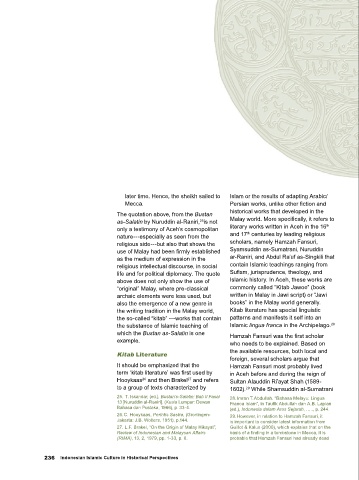Page 246 - INDONESIAN ISLAMIC CULTURE IN HISTORICAL PERSPECTIVES
P. 246
later time. Hence, the sheikh sailed to Islam or the results of adapting Arabic/ is estimated to have lived during the reign Although not in the form of poetry,
Mecca. Persian works, unlike other fiction and of the next king, Sultan Iskandar Muda Shamsuddin al-Sumatrani wrote many
The quotation above, from the Bustan historical works that developed in the (1607-1636). Both scholars held positions works, especially mystical treatises
as-Salatin by Nuruddin al-Raniri, is not Malay world. More specifically, it refers to as “Sheikh al-Islam” and served as the that belong to bookliterature. Among
25
th
only a testimony of Aceh’s cosmopolitan literary works written in Aceh in the 16 king’s advisers, especially in the field these arethe Mir’at al-Mu’minin (Mirror
th
nature---especially as seen from the and 17 centuries by leading religious of religion. The most important thing to of the faithful), Mir’at al-Iman (Mirror of
religious side---but also that shows the scholars, namely Hamzah Fansuri, emphasize here is that Hamzah Fansuri faith), Zikarat al-Dairati qaba Qawsaini
use of Malay had been firmly established Syamsuddin as-Sumatrani, Nuruddin and Shamsuddin al-Sumatrani were aw Adna (Circle ofTwo Bows Lengthor
as the medium of expression in the ar-Raniri, and Abdul Ra’uf as-Singkili that leading scholars, particularly in Aceh, in Closer to God), Mir’at al- Muhaqqiqin
th
th
religious intellectual discourse, in social contain Islamic teachings ranging from the late 16 and early 17 centuries. (Mirror of the Self-Prosecutors), Jawahir
life and for political diplomacy. The quote Sufism, jurisprudence, theology, and Hamzah Fansuri wrote many books, al-Haqa’iq (Pearl of Realities), Nur al-
above does not only show the use of Islamic history. In Aceh, these works are but what have been found until now are Daqa’iq (Light of Subtleties), and Kitab
“original” Malay, where pre-classical commonly called “Kitab Jawoe” (book three mystical treatises, respectively the al-Haraqah (Book of Gowns).
archaic elements were less used, but written in Malay in Jawi script) or “Jawi Sharab al-‘Ashiqin (Beverages of the The next Muslim scholar who made
also the emergence of a new genre in books” in the Malay world generally. Intimate People), Asrar al-‘Arifin (Secrets important contributions to the
the writing tradition in the Malay world, Kitab literature has special linguistic of the Gnostics) and al-Muntahi (End development of book literature is
the so-called “kitab” ---works that contain patterns and manifests it self into an Path). The Sharabal-‘Ashiqin is regarded Nuruddin ar-Raniri. His full name is Nur
the substance of Islamic teaching of Islamic lingua franca in the Archipelago. 28 as his first Malay workand it is also the al-Din Muhammad ibn ‘Ali ibn Hasanji al-
which the Bustan as-Salatin is one Hamzah Fansuri was the first scholar first mystical treatise in Malay. Another Hamid al-Shafi’i al-Ash‘ari al- ’Aydarusi
example. who needs to be explained. Based on version is entitled Zinat al-Muwahidin al-Raniri (d. 1068/1658). He was born
Kitab Literature the available resources, both local and (Jewelry of the Monotheists). While the in Ranir, or Randir, an old harbor city on
foreign, several scholars argue that findings on his mystical poems are only the coast of Gujarat. Ar-Raniri came to
It should be emphasized that the Hamzah Fansuri most probably lived less than 32 threads. His poems are Aceh around 1637, soon after Iskandar
term ‘kitab literature’ was first used by in Aceh before and during the reign of considered to be the first ‘Malay poetry’. Muda and Shamsuddin had died. He
Hooykaas and then Brakel and refers Sultan Alauddin Ri’ayat Shah (1589- Shamsuddin al-Sumatrani (d. 1630 was immediately granted the position
26
27
to a group of texts characterized by 1602). While Shamsuddin al-Sumatrani AD) mentioned these poems as ruba’i, of Sheikh al-Islam and in this strong
29
25. T. Iskandar, (ed.), Bustan’s-Salatin: Bab II Fasal 28. Imran T.Abdullah. “Bahasa Melayu: Lingua namely a quatrain within two misra’. 30 position he launched a religious reform
13 [Nuruddin al-Raniri], (Kuala Lumpur: Dewan Franca Islam”, in Taufik Abdullah dan A.B. Lapian in around 1527. Of course, the finding of these two movement against the Sufi doctrine of
Bahasa dan Pustaka, 1966), p. 33-4. (ed.), Indonesia dalam Arus Sejarah, ….., p. 244. scholars has been the object of dispute. Braginsky Ichtiar Baru van Hoeve, 2012), Vol.III: Kedatangan
26. C. Hooykaas, Perintis Sastra, (Groningen- 29. However, in relation to Hamzah Fansuri, it (2001) for example, is still in doubt of the Kalus & dan Peradaban Islam, p. 208-211, dan, Abdul
Jakarta: J.B. Wolters, 1951), p.144. is important to consider latest information from Guillot’sinterpretation. Hadi W.M., Tasawuf Yang Tertindas: Kajian
27. L.F. Brakel, “On the Origin of Malay Hikayat”, Guillot & Kalus (2000), which explains that on the 30. Abdul Hadi W.M., ”Tradisi Sastra dan Hermeneutik Terhadap Karya-Karya Hamzah
Review of Indonesian and Malaysan Affairs basis of a finding in a tombstone in Mecca, it is Kebahasaan”, in Taufik Abdullah dan A.B. Lapian Fansuri, (Jakarta: Yayasan Paramadina, 2001), p.
(RIMA), 13, 2, 1979, pp. 1-33, p. 6. probable that Hamzah Fansuri had already dead (eds.), Indonesia dalam Arus Sejarah, (Jakarta: 198.
236 Indonesian Islamic Culture in Historical Perspectives Indonesian Islamic Culture in Historical Perspectives 237

